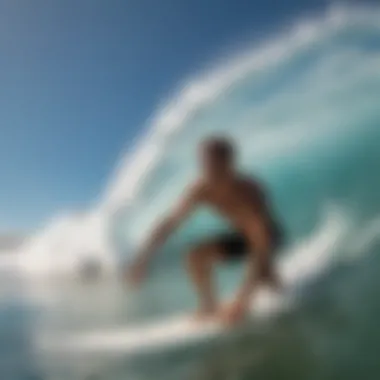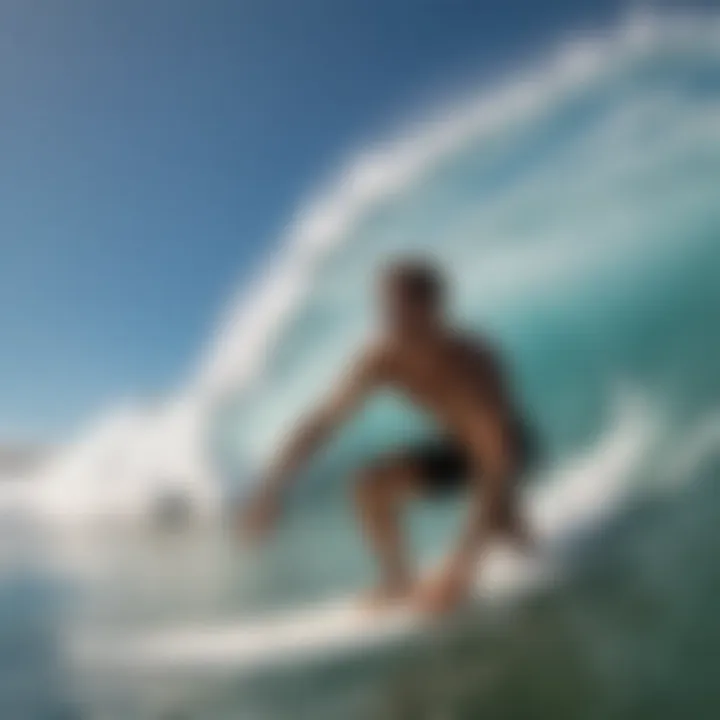Surf Workouts: Boost Your Fitness for the Waves


Intro
Surfing is not just a sport; it’s a lifestyle that melds the thrill of gliding over water with the serenity of nature. To ride those waves effectively, a solid foundation of fitness is essential. This article delves into surf workouts, aimed at enhancing the physical capabilities crucial for both beginners and seasoned surfers alike. Surfing demands balance, strength, endurance, and flexibility, and at the core of surf workouts lies a variety of exercises specially tailored to meet these requirements.
Understanding the dynamics of surf workouts starts with recognizing how these exercises can amplify performance on the water. Whether you’re a novice learning to paddle out or an advanced surfer mastering aerial tricks, each workout component serves a purpose. From building core stability to developing shoulder strength, these tailored fitness routines make a significant difference.
Key Points to Explore
- The Importance of Conditiong for Surfing: Discussing why surf workouts matter and their role in performance.
- Components of Effective Surf Training: A breakdown of essential exercises that enhance fitness.
- Techniques for All Skill Levels: Tips and tricks ranging from beginner-friendly workouts to advanced techniques.
- Resources to Optimize Training: Insight into where to find additional support and gear for surf fitness.
By the end of this exploration, surfing enthusiasts of all levels will have a better understanding of how to optimize their workouts, improve their fitness, and ultimately, their performance on the waves. Let's dive into the fundamentals of surf workouts.
Intro to Surf Workouts
Surf workouts create a bridge between the thrill of catching waves and the disciplined regimen of fitness. As surfers, many of us chase the next swell, often neglecting the physical and mental demands that come with it. Understanding the intrinsic value of surf workouts can drastically enhance performance in the water. This article will probe into how tailored fitness regimes can elevate one's surfing experience while ensuring longer, more enjoyable sessions.
A workout focused on surfing isn’t just about paddling a board. It’s about developing strength, endurance, and flexibility specifically to navigate the complexities of the waves. By engaging with surf workouts, individuals can enhance their stability on the board — allowing for better wave handling and more fluid transitions.
The Benefits of Surf Workouts
Surf workouts offer a multitude of benefits:
- Enhanced Performance: Specific training translates directly to better surfing skills, allowing for sharper turns and improved balance.
- Injury Prevention: A strong core and flexible body help stave off common injuries. The right workout can keep surfers riding rather than sidelined.
- Overall Fitness: Working out for surfing doesn’t just make you better in the water; it promotes overall stamina, strength, and health.
People often select vacation spots based on surfing conditions but may forget that fitness plays a vital role in enjoying and maximizing those experiences. Without the stamina to last through multiple waves or the strength to pop up quickly, even the most breathtaking surf spots can quickly become frustrating.
The Synergy of Surfing and Fitness
Surfing demands an artful mix of power, balance, and agility, making it necessary to approach workouts with a keen understanding of these requirements. Surf workouts integrate core-centric routines that mimic the movements made while paddling, popping up, and riding waves. Strong muscle groups such as the shoulders and legs are vital for maintaining proper surfing stance and movement.
Moreover, surf workouts can also boost mental fortitude. Surfing isn't just a physical challenge; it’s also a mental game. Practicing fitness routines that instill discipline and focus translates well onto the waves. Getting mentally comfortable with physical strain while working out is essential in being adept in the water where conditions can shift unexpectedly.
Understanding the Requirements of Surfing
Surfing isn’t merely about hopping on a board and riding the waves. It requires an intimate knowledge of ocean dynamics, wave patterns, and personal limits. Each surfer has unique requirements based on their individual style and experience level. For beginners, connectivity with the ocean may necessitate a focus on paddle strength and balance control, while seasoned surfers might consider endurance and high-intensity training to tackle bigger breaks.
Before diving headfirst into workouts, it’s paramount to understand one’s personal fitness level and goals. Learning to listen to your body can greatly aid in avoiding overexertion or injury. Surfers serious about their practice might also consider integrating elements of yoga or Pilates for better core stability and increased flexibility.
In summary, embracing surf workouts is not just a trend but rather a foundational step towards enhancing one’s surfing journey. These workouts, when designed appropriately, can yield significant returns, allowing enthusiasts to not just meet but exceed their ocean aspirations.
Physical Demands of Surfing
Surfing is more than just gliding on water; it's a full-body workout that comes with its own set of physical challenges. Understanding these demands is crucial for anyone who aims to excel in the sport. As surfers, we need to develop our bodies in ways that specifically enhance our performance in the waves. These physical requirements don’t just improve our surfing; they also contribute to a healthier lifestyle overall. The focus on strengthening our bodies in these key areas leads to not only better rides but also increased enjoyment of this exhilarating sport.
Core Strength and Balance
When you think of surfing, the notion of core strength likely comes to mind. The core is the central link in the body's functionality, and for surfers, it's the powerhouse that controls balance, stability, and movement. Engaging the core allows for precise shifts in weight, enabling surfers to adjust seamlessly to the changing dynamics of waves. A strong core also significantly reduces the risk of injuries, particularly in the back and abdomen.
Practicing exercises like planks, Russian twists, and bridging can work wonders in fortifying this area. When a surfer feels the need to make quick adjustments, it’s their core that keeps them grounded, allowing for fluid transitions as they maneuver through the green walls of water. In essence, core strength is not optional; it is the foundation upon which effective surfing rests.
Endurance for Extended Sessions
To ride waves all day long, endurance is key. Surfing for extended sessions requires both muscular and cardiovascular endurance. A surfer who can paddle out to the lineup without gasping for air is more likely to catch those juicy waves as they roll in. Building endurance helps in maintaining technique and energy levels, allowing surfers to stay engaged and active throughout their time on the water.
Interval training can be a game-changer here, blending bursts of high-intensity activity with recovery periods. This not only boosts stamina but also mimics the stop-and-start nature of surfing. Endurance can be developed through activities like running, cycling, or even swimming—anything that keeps the heart rate up for sustained periods.
Flexibility and Agility
Surfers need flexibility and agility to adapt to various wave conditions and overcome unexpected challenges. A flexible body allows for easier transitions, twisty movements, and prevents muscle strains that can arise from the dynamic nature of surfing. Being agile, on the other hand, means having the capability to change direction and shift weight almost in an instant. This is particularly essential for reacting to the wave's push and pull.
Incorporating stretching routines, yoga sessions, or dynamic movement exercises into one’s surf workout will significantly enhance flexibility. Not only does it help achieve those critical range-of-motion requirements, but it also fosters mindfulness—keeping surfers connected with their bodies.


"Flexibility and agility are your best friends in the surf; they keep you nimble and ready to dance with the waves."
Components of an Effective Surf Workout
When it comes to surf workouts, the goal is more than just building a beach body; it’s about understanding the dynamics of each physical facet that enhances performance on the waves. Surfing places unique demands on the body, requiring strength, endurance, and flexibility. Each component of an effective surf workout plays a vital role in achieving a surfer's potential. An integrated approach to fitness can drastically improve paddle power, wave-catching ability, and overall endurance. Let's explore what makes an effective surf workout beneficial and essential to any serious surfer.
Warm-Up Techniques for Surfing
Starting off on the right foot, or maybe the right board, requires proper warm-up techniques. A good warm-up not only prepares your muscles for the rigorous activities ahead but also reduces the risk of injuries. To get the blood flowing, consider dynamic stretches, such as arm circles and leg swings, which target the shoulders and legs — two areas heavily engaged in surfing. Another great warm-up could be hopping on a paddleboard in still water for light paddling to ease into the motions without overexerting yourself.
A well-planned warm-up routine can include:
- Paddling drills: Light paddling to mimic surf conditions.
- Dynamic stretches: Movement-based stretches focusing on muscle groups used in surfing.
- Mobility exercises: Targeting hips and shoulders, improving range of motion.
"A thorough warm-up is like oil for your surfboard; it keeps everything running smooth on the waves."
Strength Training Regimens
Strength training is a non-negotiable component that can set a surfer apart from the pack. Given the necessity for raw power when paddling or performing maneuvers, engaging in focused strength training can increase muscle mass and enhance explosive power. Focus on compound exercises that engage multiple muscle groups such as squats, deadlifts, and bench presses. The goal is to develop not only upper body strength but also leg power and core stability.
Here’s what to consider when creating a strength training regimen:
- Push and Pull Exercises: These help balance muscle development. Incorporating pull-ups and push-ups can greatly assist in building the specific muscles you use while paddling.
- Leg Work: Lunges and kettlebell swings for leg and glute strength, crucial for powerful takeoffs.
- Core Work: Plank variations and medicine ball workouts to engage and strengthen the entire core.
Cardio Training for Resilience
To catch waves all day long, surfers need a solid cardio foundation. Cardiovascular training helps improve lung capacity and overall endurance. Activities such as running, swimming, or cycling can provide a robust system of conditioning. Interval training, specifically, can mimic the bursts of energy needed to paddle out through waves and catch rides.
Focus on:
- Steady-state aerobic exercise: Activities like jogging or swimming for longer durations.
- High-intensity intervals: Short bursts of intense activity, followed by rest, which mimics the obligation of exertion in surfing.
Flexibility Exercises and Yoga
Flexibility is often the unsung hero in surf workouts but is essential for performance and injury prevention. Tight muscles, especially in the hips and back, can limit motion and affect balance on the board. Incorporating yoga into your routine not only helps with flexibility but also provides mental focus and breath control, key components when navigating the surf.
Key practices might include:
- Downward Dog: For full-body stretching, helping to align the spine and activate the hamstrings.
- Pigeon Pose: Specifically targets hip flexibility, improving range of motion for paddling.
- Flow sequences: Help enhance movement fluidity which can translate to better maneuverability on the waves.
By building an effective surf workout plan that incorporates these elements—warming up, strength training, cardio, and flexibility—you effectively prepare your body to handle the challenges of the ocean. Each component works synergistically to not only improve your surfing skills but also enrich your overall fitness journey.
Popular Surf Workout Practices
Engaging in surf workouts isn't just about building muscle or improving flexibility; it’s about fostering connection with the ocean and enhancing one's surfing experience. Popular surf workout practices bridge that gap between fitness and surfing, offering various methods tailored expressly for those who seek to conquer the waves. Let’s dive deeper into three standout practices that are pivotal to any surf fitness regime.
Paddle Training
Paddle training is a cornerstone of surf workouts, building the essential upper body strength and endurance required for navigating the surf. Essentially, this sort of training simulates the motions made during paddling out to waves, which can be surprisingly intense. Surfing demands not only brute force but also stamina, and focused paddle training can significantly improve both.
To implement paddle training:
- Utilize a Paddle Board: Spend time on a paddle board, even in flat water. It helps simulate the conditions of the ocean while giving your muscles the workout they crave.
- Resistance Exercises: Resistance bands are an excellent tool here. They allow for multifunctional workouts, great for mimicking paddling movements.
- Swim Training: Regular swimming can augment paddle endurance, which in turn translates to performance when conquering waves.
"Every stroke counts at sea. Paddle training transforms effort into experience, building the roots of your surfing ability."
By integrating paddle training into a routine, surfers not only enhance muscle control but also significantly improve their stamina, allowing for longer, more exhilarating surf sessions.
Balance Training Techniques
Balance is paramount for any surfer trying to stay upright on their board while grappling with the unpredictability of waves. Improving balance goes beyond just standing on one foot; it encompasses a range of exercises that can be integrated into a regular fitness regime. Techniques like using balance boards, stability balls, or even doing yoga can dramatically improve one’s center of gravity and stability on the surfboard.


Here are a few effective balance training exercises:
- Balance Board Practice: Spending even a few minutes daily on a balance board can contribute immensely to a surfer’s stability.
- Single-leg Exercises: Movements that engage one leg at a time will force your core to stabilize, which is pivotal for surfing.
- Yoga: The incorporation of yoga, particularly postures like Warrior III or Tree Pose, enhances both balance and mental focus.
By honing in on balance, surfers can ride more confidently and are less susceptible to falls, thus making their sessions safer and more enjoyable.
High-Intensity Interval Training (HIIT)
High-Intensity Interval Training, or HIIT, presents a dynamic approach for surfers wanting to maximize their workouts in shorter timeframes. HIIT involves alternating bursts of intense activity with periods of rest or lower-intensity exercise. This method is beneficial for surfers who often engage in short, exhilarating bursts of energy when catching waves.
Incorporating HIIT into surf workouts can be done through:
- Sprints: Fast-paced sprinting followed by walking provides excellent cardiovascular benefits that mimic the demands of paddling out to catch waves.
- Shuttle Runs: These quick that go back and forth help in building speed and explosive power, essential when positioning on the board.
- Bodyweight Circuits: Exercises like burpees, push-ups, and mountain climbers can be performed in a HIIT style to build strength and endurance simultaneously.
HIIT not only contributes to improved physical fitness but also boosts mental agility, which surfers need when navigating ever-changing water conditions.
In summary, integrating these popular surf workout practices into a fitness routine can enhance one’s surfing capability and overall performance. Surfing isn’t just about the thrill; it’s about preparation, and with the right workouts, enthusiasts can become stronger, more agile, and ready to take on the ocean's challenges.
Crafting a Personalized Surf Workout Plan
Creating a tailored surf workout plan is not just about following a cookie-cutter routine; it’s about aligning your workout to meet your individual needs and objectives. The waves can be unpredictable, and so too can your fitness journey. This section emphasizes the importance of understanding your unique body, surfing style, and goals. A personalized plan can enhance performance, boost confidence, and reduce the risk of injuries, making it vital for any serious surfer.
Assessing Individual Needs and Goals
Before diving into a workout plan, it's crucial to pause and reflect. What are you trying to achieve? Are you aiming to boost overall strength, increase your paddling power, or refine your balance on the board?
To effectively assess your needs:
- Evaluate Your Current Fitness Level: Take stock of where you stand. Are you a seasoned surfer in search of that competitive edge, or are you just starting out?
- Set Clear Goals: These should not be vague aspirations but specific targets. For instance, you might want to improve your endurance so you can catch more waves in one session.
- Consider Your Unique Body Mechanics: Everyone’s body works differently. Take into account any previous injuries, your body’s flexibility, and how you react during a wave ride.
"Your body is your best tool for surfing; treat it like a well-tuned surfboard."
Integrating Surfing Techniques into Fitness Routines
The heart of a surf workout lies in integrating techniques that mimic the movements experienced on the water. Focusing on surf-specific exercises not only prepares your body for what’s to come but also sharpens your skill set. Consider these incorporation methods:
- Movement Patterns: Incorporate paddling motions, pop-ups, and turns into your workout. This could involve using a resistance band mimicking paddle strokes or performing balance drills that replicate the stance on a surfboard.
- Functional Training: Engage in functional movements—think lunges and squats—that enhance your core stability and strength. These exercises help simulate the feel of the board beneath your feet as you transition from one maneuver to the next.
- Agility and Footwork Drills: Use cones or markers to practice quick directional changes, which can be invaluable when riding waves.
Adapting Workouts for Different Skill Levels
Not every surfer is cut from the same cloth, and that’s what makes the ocean such an adventure. Your workout should be just as flexible as your surfing. Here are some tips on how to mold your exercises based on your proficiency:
- Beginners: Focus on foundation-building exercises that promote overall strength and coordination. Yoga can be an excellent way for novices to improve flexibility while enhancing their board skills.
- Intermediate Surfers: Your attention should pivot towards endurance and strength. High-intensity intervals that include surf-specific movements can bridge the gap between good and great.
- Advanced Surfers: Emphasize power and explosiveness. Engaging in plyometrics and resistance training can help you pop up swiftly and maintain balance during complicated maneuvers on the board.
Incorporating these considerations into your personalized surf workout plan will better prepare you for the adventures that lie ahead. As the surf changes, so too can your routine. Keep it dynamic, keep it fun, and most importantly, keep it you.
Nutrition and Hydration for Optimal Performance
In the exhilarating world of surfing, where every wave is an opportunity and every session pushes physical limits, nutrition and hydration emerge as foundational pillars for achieving peak performance. Understanding the intricate needs of the body—especially when it’s subject to the unique demands of surf workouts—can significantly influence one’s endurance, recovery, and overall prowess in the water.
Focusing on these crucial aspects not only ensures that surfers can conquer challenging waves but also promotes longevity in the sport. Amid the salty air and sunny afternoons, correct nutritional strategies cannot be an afterthought; they are essential for optimal physicality in every movement, stroke, and take-off. Let’s unpack this further by first looking at the nuts and bolts weaving through the concept of nutritional needs.
Understanding Nutritional Needs
Surfing requires a unique blend of strength, agility, and stamina, so it follows that surfers need a well-rounded diet to fuel their bodies properly. Here’s a closer inspection:
- Macronutrients: Balancing carbohydrates, proteins, and fats is key. Carbs are particularly vital as they provide quick energy for paddling and other high-intensity activities. Surfers should aim for complex carbohydrates from sources like whole grains and fruits. Protein, crucial for muscle recovery, can come from birds, fish, and beans.
- Vitamins and Minerals: Surf workouts can lead to the loss of essential vitamins and minerals through sweat and exertion. Incorporating leafy greens, nuts, and seeds can replenish these vital nutrients, playing a role in muscle recovery and immune support.
- Timing of Meals: The timing of meals is almost as critical as the food itself. Consuming a balanced meal rich in carbs and protein a few hours before a surf session can maximize energy levels. Post-surf, a combination of protein and carbs helps jumpstart recovery.
"To ride the perfect wave, one must first have the strength to paddle out. Nutrition is the fuel that drives this strength."
Ultimately, the mantra is to listen to your body and adjust your intake based on both your individual needs and the duration of the surf session. Pre-planning meals for surf trips can mitigate fatigue during those lengthy days on the water and ensure peak performance.


Hydration Strategies for Surfing
Hydration strategies often take a backseat in the realm of workout discussions, yet they play a decisive role in performance, especially under the sun and surf. Here’s how to stay on top of your hydration game:
- Water Intake: The most straightforward strategy is consistent water intake before, during, and after surf sessions. Remember that thirst only kicks in after dehydration has begun, so regularly sipping water throughout the day can help maintain optimal levels.
- Electrolyte Balance: The ocean can be a salty environment, and as surfers sweat, they lose valuable electrolytes like sodium, potassium, and magnesium. Electrolyte drinks or natural sources such as coconut water and bananas can efficiently restore this balance, preventing muscle cramps and fatigue.
- Recognizing Signs of Dehydration: It is vital to be attuned to your body. Signs of dehydration might include headaches, dry mouth, dizziness, or decreased urinary output. As simple as it may seem, regular checks on hydration can prevent significant dips in performance.
- Adapt Plan to Conditions: Adapt hydration strategies according to weather and water temperature. On sweltering days, increase water intake to accommodate higher sweat loss. Likewise, cooler water may mask dehydration until it becomes severe, requiring vigilant monitoring.
Injury Prevention in Surf Workouts
Surfing, as exhilarating as it might be, also possesses inherent risks. The potential for injuries can stem from various factors including technique, physical condition, and environmental elements. Therefore, focusing on injury prevention during surf workouts is paramount for surfers of all skill levels. Such preventative measures not only enhance one's performance but also prolong a surfer's career on the waves. Being proactive about injury prevention can make the difference between spending hours catching waves and being sidelined by avoidable accidents.
Common Surf Injuries and Their Causes
Injuries in the surfing world can often arise from a mixture of poor conditioning, inadequate warm-ups, and environmental challenges. Here are some of the more common injuries that surfers face:
- Shoulder Injuries: Overhead paddling can lead to rotator cuff injuries. These injuries usually occur due to repetitive strain without adequate rest.
- Lower Back Pain: The twisting motion as surfers paddle can put undue stress on the lower back, especially if core muscles lack strength.
- Knee Injuries: From abrupt turns or falls, knee injuries, such as ACL strains, frequently occur due to poor technique.
- Wrist Sprains and Fractures: A wipeout can lead to a surfer putting their hand down to break a fall, often leading to wrist injuries.
To keep injuries at bay, understanding the causes of these issues is the first step in a surfer's training.'
Awareness is half the battle. Incorporating strength training, flexibility exercises, and proper technique can significantly aid in reducing injury risk.
Safe Practices During Workouts
When engaging in surf workouts, one key aspect to remember is the importance of safety-first practices. Here are several effective strategies:
- Always Warm-Up Properly: Engaging in targeted stretching of major muscle groups is essential. A good routine might include dynamic stretches like arm circles and leg swings to prepare the body.
- Listen to Your Body: Pushing through pain can lead to serious injuries down the line. If something feels off, it’s wise to adjust your workout or seek advice from a professional.
- Incorporate Recovery Time: Rest days are just as important as workout days. Muscles need time to heal and strengthen; otherwise, they can become fatigued.
- Utilize Correct Technique: Whether it's paddling or popping up on the board, correct maneuvers reduce strain on the body. Consider seeking feedback from an instructor if unsure.
- Modify Workouts for Conditions: Weather and water conditions play a crucial role. On days when the waves are particularly fierce, scale back the intensity or focus more on balance and core training instead of high-impact workouts.
By implementing these safe practices, surfers can significantly lower the chances of encountering injuries and thus enjoy more time on the board, getting the most out of their surf workouts.
Technology's Role in Surf Workouts
In today’s fast-paced world, technology has danced its way into nearly every aspect of our lives, including how we approach surf workouts. From tracking performance to enhancing recovery, a myriad of technological innovations supports the dedicated surfer in reaching peak fitness levels. For an individual seeking to ride the waves with more skill and less injury, understanding this role isn’t just beneficial; it’s essential.
Historically, surfers relied on intuition and experience to gauge their fitness and technique. However, the dawn of wearable technology and fitness apps has transformed this reliance into something data-driven. This enables surfers to focus their training efforts more effectively, marking a significant shift in how surfers cultivate their craft.
Wearables and Fitness Trackers
The rise of wearables has revolutionized the way surfers monitor their workouts. Devices such as the Fitbit Charge or the Apple Watch are now equipped with features tailored for water sports.
- Heart Rate Monitoring: Keeping an eye on heart rates during paddling and riding waves can help surfers gauge their intensity levels and recover effectively.
- GPS Tracking: Surf-specific trackers can monitor distances traveled while paddling, offering insights into endurance and efficiency.
- Motion Sensors: Some devices analyze movements and help in perfecting balancing techniques, crucial to maintaining control while riding waves.
These wearables not only track metrics but also foster accountability. Surfers can share their achievements with friends, creating a friendly competitive atmosphere that pushes for better performance. As a surfer engages regularly with these devices, they foster a training rhythm that aligns with their unique fitness goals.
"By measuring progress through tech, surfers turn every wave into a lesson learned."
Apps for Training and Scheduling
In tandem with wearables, a plethora of apps have emerged, designed to make training more structured and efficient. Popular options like Strava and MyFitnessPal cater to surfers of all skill levels. These applications offer several functionalities, including:
- Pre-Surf Workouts: They provide suggested exercises that target essential muscle groups used in surfing, helping prepare individuals for their sessions.
- Workout Logs: Surfers can document their workouts, helping them identify patterns in performance over time.
- Nutrition Tracking: Many apps now come with meal planning features tailored to help surfers maintain energy levels while promoting recovery.
Moreover, scheduling tools within these apps help surfers maximize their time on the water by reminding them to hydrate and follow their training regimens diligently. This deliberate approach to scheduling not only enhances performance during surf sessions but encourages a holistic view of fitness overall.
Integrating technology into surf workouts represents a blend of tradition and progress. As surfers navigate their fitness journeys, the data gleaned from wearables and apps becomes a compass, guiding them to refine their techniques, maintain their health, and ultimately, conquer the waves with greater skill.
Finale
The realm of surf workouts goes beyond merely honing one’s physique; it's about crafting a holistic approach that intertwines fitness with the joys of surfing. This article has unpacked the multifaceted nature of surf workouts, delivering insights into components that collectively enhance one's surfing performance.
The Continual Journey of Fitness in Surfing
In a sport like surfing, where the ocean is as unpredictable as it is alluring, the journey of fitness must be as dynamic as the waves themselves. Surfers need to embrace a routine that’s as fluid as their motions on the board. The continual journey of fitness in surfing isn’t just a means to an end; it’s a vital aspect of the surfing lifestyle.
- Adaptation is Key: As conditions change, so too must a surfer’s approach to fitness. This means regularly updating workout plans to incorporate new techniques, enhancing areas that need work, and keeping fitness engaging.
- Injury Prevention: A strong physical foundation helps mitigate risks associated with surfing, which can be a sport that puts significant strain on the body. Maintaining flexibility and core strength can prevent common injuries.
- Mind-Body Connection: Fitness in surfing is profoundly mental as well. Exercises that cultivate focus and mental resilience can elevate surfing performance. A calm and concentrated mind leads to better wave selection and maneuvering.
- Community Engagement: Joining surf fitness classes or connecting with like-minded surfers allows individuals to learn from one another and share best practices. The camaraderie found within the surfing community can provide motivation and encouragement.
- Nutrition and Recovery: As explored in previous sections, proper nutrition and recovery methods play a significant role in fitness. Surfers should prioritize balanced diets and recovery strategies to keep their bodies in optimal shape for surf sessions.
"Surfers often say that there’s nothing like the feeling of riding a wave. This thrill is made all the more satisfying when you know you've put in the work to be at your best."
In essence, the journey doesn’t end with a toned body or with mastering advanced surf techniques. It's an ongoing commitment to integrating physical wellness with the joys of surfing. By nurturing the body, mind, and spirit, surfers can not only excel but also deepen their connection to the ocean and the sport they love.















